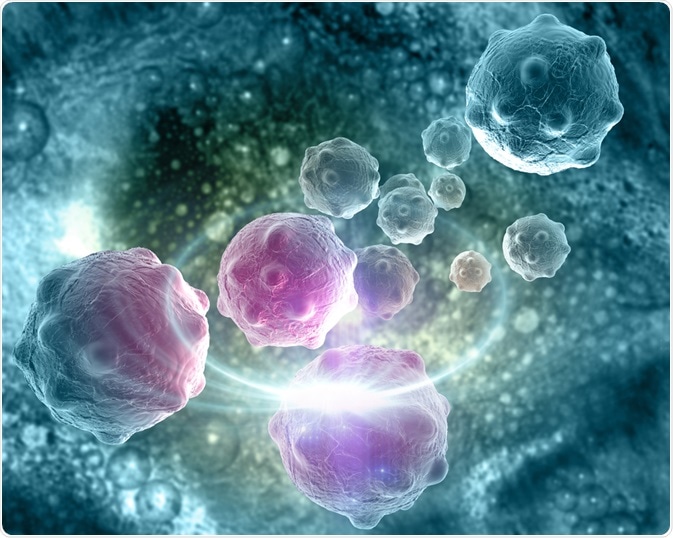How are cancer cell lines used in research?

Image Credit: Jovan Vitanovski/Shutterstock.com
Cell lines derived from cancer cells are frequently used in research, including use as a model to understand cancer and to identify potential new treatments. These cell lines, such as the HeLa cells, are “immortalized” and so continuously grow.
However, there have been questions about how relevant the studies carried out on these cell lines are, particularly in the face of contamination and misidentification of the cell line.
So, why are they still used? - One factor that should be taken into account is that there is a limited possibility to use tumor samples, therefore having something established like cancer cell lines is a viable alternative.
Cancer cell line panels for drug discovery
Initially, there was limited success in translating discoveries made using cell lines to benefit patients. In the late 1980s, this led to the development of the NCI-60 panel. This consists of a collection of human cancer-derived cell lines, which aimed to take the treatment response variations within a type of cancer into account.
The NCI-60 panel consists of 60 cancer cell lines derived from 9 types of cancer and was officially launched in 1990. One notable successful use of a cancer cell line panel was the development of a proteasome inhibitor as a treatment option for multiple myeloma.
Can genomic information lead to better use of cancer cell lines? – a modern perspective
As DNA sequencing technology improves and becomes cheaper, it becomes easier to gather genome information. So, it has become increasingly easier to analyze tumors for changes within the genome that may be linked to how that tumor came to be.
This provides vital information, as certain changes in the genome have been shown to affect treatment response. Various studies, including those that form The Cancer Genome Atlas and the International Cancer Genome Consortium, provide comprehensive information on genomic variations that are involved in the development of cancer.
Due to the expense and difficulty of clinical trials, it is beneficial if there are other robust models available that would enable researchers to study the development of cancer.
For this, human cancer cell lines offer a viable model, and they have been widely used as a starting point in the quest to identify potential treatments. However, this screening system was limited in the past due to an incomplete understanding of how genomic variations drive cancer progression.
Iorio and co. wanted to make use of the genomic variation information gathered from 11,289 tumors to study how certain genomic variations were linked to sensitivity towards 265 anti-cancer compounds. Here, they used 1001 cancer cell lines that were annotated so that the genomic variations could be matched between the tumor samples and the cancer cell lines.
By using this approach, the author managed to find novel genomic variations that could potentially be used as markers for treatment sensitivity that otherwise may not have been picked up. This then means that it could be possible to not only match certain cancer genomic profiles to specific treatments, as well as providing a way of grouping patients for clinical trials.
Use of lung cancer cell lines for translational research
Today, there are about 200 lung cancer cell lines available, derived from small cell and non-small cell lung carcinomas.
As mentioned in the above example genomic variations can drive cancer progression, and lung cancer cell lines played a vital role in the discovery of these “driver mutations” and genes that are linked to the progression of lung cancer.
For example, functionality tests, which are not feasible using tumors, were performed on cell lines, which then separated these driver mutations from “passenger mutations”. Other studies have established that regions of the genome that were shown to undergo changes in lung tumors were represented in lung cancer cell lines, with many of these sites known to contain genes linked to the pathogenesis of lung cancer.
So, while there are identified issues with cell lines, the use of cancer cell lines has led to the use of proteasome inhibitors as a treatment for multiple myeloma, yielded information on which genetic changes were the “drivers” of lung cancer, and may in the future reveal which genetic variations are linked to treatment susceptibility.
Sources
Gillet, J.-P. et al. (2013) The Clinical Relevance of Cancer Cell Lines. Journal of the National Cancer Institute https://www.ncbi.nlm.nih.gov/pmc/articles/PMC3691946/
Iorio, F. et al. (2016) A Landscape of Pharmacogenomic Interactions in Cancer. Cell www.cell.com/.../S0092-8674(16)30746-2
Gazder, A. F. et al. (2010) Lung Cancer Cell Lines as Tools for Biomedical Discovery and Research. Journal of the National Cancer Institute https://academic.oup.com/jnci/article/102/17/1310/2515936
Further Reading